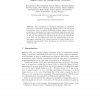Free Online Productivity Tools
i2Speak
i2Symbol
i2OCR
iTex2Img
iWeb2Print
iWeb2Shot
i2Type
iPdf2Split
iPdf2Merge
i2Bopomofo
i2Arabic
i2Style
i2Image
i2PDF
iLatex2Rtf
Sci2ools
PPSN
2004
Springer
2004
Springer
The Ising Model: Simple Evolutionary Algorithms as Adaptation Schemes
The investigation of evolutionary algorithms as adaptation schemes has a long history starting with Holland (1975). The Ising model from physics leads to a variety of different problem instances and it is interesting to investigate how simple evolutionary algorithms cope with these problems. A theoretical analysis is known only for the Ising model on the ring and partially for the Ising model on the two-dimensional torus. Here, the two-dimensional torus, the d-dimensional hypercube, and graphs consisting of two cliques connected by some bridges are investigated experimentally. Many hypotheses are confirmed by rigorous statistical tests.
Distributed And Parallel Computing | Evolutionary Algorithms | Ising Model | PPSN 2004 | Two-dimensional Torus |
Related Content
| Added | 02 Jul 2010 |
| Updated | 02 Jul 2010 |
| Type | Conference |
| Year | 2004 |
| Where | PPSN |
| Authors | Patrick Briest, Dimo Brockhoff, Bastian Degener, Matthias Englert, Christian Gunia, Oliver Heering, Thomas Jansen, Michael Leifhelm, Kai Plociennik, Heiko Röglin, Andrea Schweer, Dirk Sudholt, Stefan Tannenbaum, Ingo Wegener |
Comments (0)

